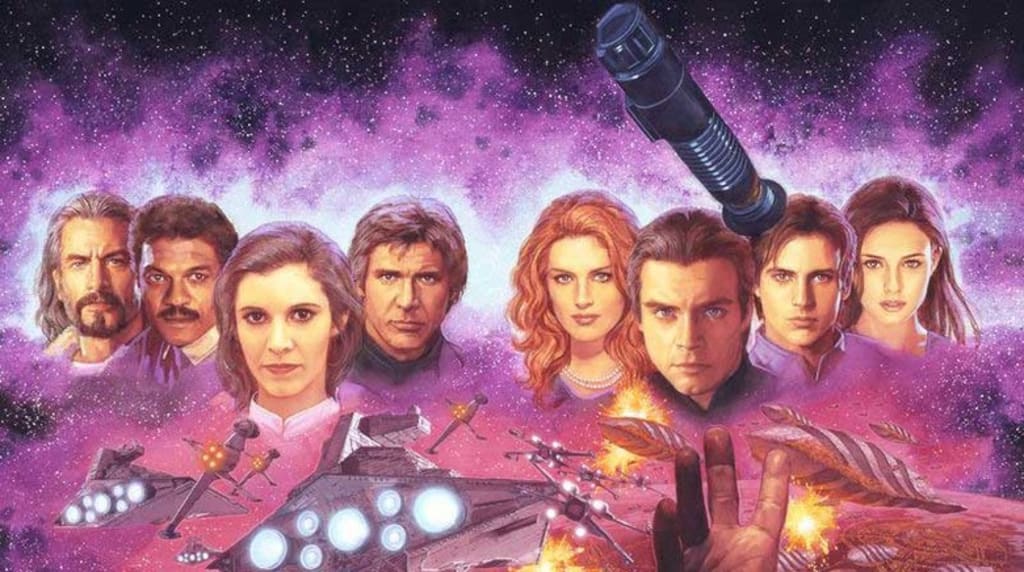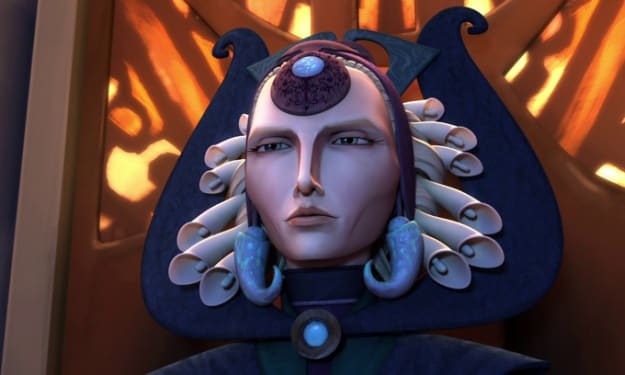The History of the “Star Wars Expanded Universe” (Legends”) Series
Let’s take a thorough analysis of the history of and controversy surrounding the books, games, and comics that covered the “Star Wars” brand for decades.

The Star Wars Expanded Universe series, also known as Legends, is a collection of books, games, and comics that explore various characters, in-story elements, and world-building aspects of the Star Wars universe. These stories take place within the timeframe of the original trilogy and beyond. The series started in 1978 with the publication of the spin-off novel Splinter of the Mind's Eye.
The Legends series begins approximately 36,591 years before the events depicted in The Phantom Menace, focusing on the rise of the Jedi. Over the years, the series has been a debate among fans, with original creator George Lucas and his successor Dave Filoni referring to the stories as "non-canonical." This distinction became significant in 2014 when Lucasfilm rebranded the EU series as Legends to allow Disney, the parent company, to produce new material for the official canon.
Why Was the Expanded Universe Series Produced?
In the early days of the Expanded Universe (EU), a lack of official materials limited creators' ability to build upon the Star Wars universe. As a result, works like Splinter of the Mind’s Eye drew inspiration from early drafts of A New Hope and Empire Strikes Back. Notably, Alan Dean Foster, the author of Splinter of the Mind’s Eye, ghostwrote the novelization of A New Hope, though George Lucas received sole credit.
Following the success of the original trilogy in the early 1980s, EU material diverged from the holistic fictional world presented in the movies, incorporating real-world analogies. This departure is now seen as detaching from the rest of the series. In 1987, a roleplaying book based on the trilogy was published, providing supplemental material for creating recent adventures. It included information on the Aurebesh alphabet and previously unknown alien species.
In 1992, Timothy Zahn's Thrawn trilogy debuted, originally considered a series of “unproduced sequels.” These books significantly affected the Star Wars literature scene, with the titular villain later appearing in canon works like Star Wars: Rebels and Ahsoka. Around the same time, Dark Horse Comics gained the rights to publish Star Wars comics and released several “sequels” to the original trilogy, including the Dark Empire stories.
The publication of these stories was financially lucrative for Lucasfilm, particularly after the release of The Phantom Menace. While these stories were not intended to be canon, they were part of a separate timeline where events from the films occurred alongside them.
What Were the Rules For Writing An EU Book?
Of the many reasons Star Wars was created was to allow people to unleash their imaginations, and George Lucas welcomed other artists to take part in the world he devised. However, when new material surfaced, Lucas informed Lucas Licensing and other authors that the Prequel era was off-limits. This was because he was developing those films himself, wanting to unveil the stories personally. Authors were free to create sequels to the original trilogy as they pleased.
George was scarcely involved in creating the EU series. His role was limited to providing a series of "Yes or No" questionnaires regarding what writers could or could not write about. For instance, writers could craft stories of Luke Skywalker establishing his Jedi Order following Return of the Jedi, while others could write about Leia's life with her step-parents on Alderaan or Han's backstory and his rise to notoriety as a smuggler. However, they were prohibited from delving into Yoda's history or having other characters assume Darth Vader's suit after his demise.
The Mara Jade Controversy
The character Mara Jade ignited one of the first controversies surrounding the EU series. For those unfamiliar with the EU character lineup, Mara Jade Skywalker, a Force-sensitive assassin, served and operated for Emperor Palpatine. While working for him, Mara carried out his bidding, assassinating rebels and corrupt imperials. Her journey strengthened from a Sith to a smuggler to a Jedi Master, alongside her husband, Luke Skywalker, in his New Jedi Order.
As a character, Mara Jade posed little of an issue for George Lucas until she married Luke. When Timothy Zahn proposed the idea of Luke being engaged or married to Mara in the early 90s, Lucasfilm rejected the idea. Lucas envisioned Jedi-like monks, who do not marry nor have or raise families. They may not form attachments to those around them, as it makes them vulnerable to the dark side of the Force. Additionally, George reportedly disliked Mara Jade because of her being modeled after a real-life model, which went against his vision for the franchise.
Despite the controversies, Mara remains a beloved character from the EU brand among fans and appears as a playable character in the Disney-produced Star Wars: Galaxy of Heroes game. Merchandise related to Mara, including her lightsaber, can be purchased at various retailers and gift shops in Star Wars: Galaxy's Edge within Disney Parks in the United States. Fans eagerly expect her appearance in a canon Star Wars feature film, novel, or live-action series soon, with many theories speculating on how she might be incorporated into the official Star Wars storyline.
The One-Way Relationship
In the wake of the Prequel movies, which introduced new characters, concepts, and plotlines, licensing the parallel timeline within the original trilogy required internal consistency and adherence to the Prequel additions. While Lucas did not need to involve himself in the details, he established guidelines and boundaries that authors had to follow. Within these boundaries, authors had the freedom to interact with editors from various publishers and Lucas Licensing. Only on rare occasions did Lucas sign off on stories that were major plot points and aligned with his vision.
It is important to note that the EU series were not Lucas' stories; rather, they were interpretations of his creations. Some writers were unfamiliar with the Prequels and created lore that was inconsistent with the plot points introduced there. Some authors disagreed with Lucas' vision but still wanted to engage with the material. As a result, some EU stories fixed plot holes and inconsistencies, such as Ki-Adi Mundi being a married Jedi with multiple children or Jedi having superpowers like the X-Men.
Then Came The Shows
Following the release of Revenge of the Sith, George Lucas collaborated with Dave Filoni to create The Clone Wars series. Filoni, a devoted Star Wars enthusiast, would often present EU material to Lucas during production meetings, incorporating ideas into their work. Lucas' stance remained consistent, regarding the EU content as a library of "what-if" inspiration rather than official canon.
One notable example is Karen Traviss' EU books featuring Boba Fett, Mandalorian culture, and clone troopers. In the Legends continuity, Mandalorians were depicted as a society of warriors, practicing their culture through bounty hunting and mercenary work. They also taught the clones to speak Mando'a and adhere to their cultural beliefs.
However, the portrayal of Mandalorians was significantly altered in The Clone Wars, where they were reimagined into two distinct political groups: the radical Death Watch, clinging to the old warrior ways, and the New Mandalorians, advocating for a shift toward pacifism and evolution beyond their previous traditions. This change sparked controversy, causing Traviss to depart from Lucasfilm.
For Lucas and Filoni, the primary source of the canon was limited to Lucas' own words, the Star Wars films, and the canon shows: Clone Wars, The Bad Batch, Rebels, and The Mandalorian. Any previously established lore that contradicted these sources was non-canonical.
Recent Disney-produced live-action shows have integrated elements of Traviss' original vision for the Mandalorian characters into the official canon. These additions include the revelation that Jango Fett was the adopted son of Jaster Mereel and the establishment of Mandalorians as mercenaries for other planets.
The Disney Era
In 2012, before selling Lucasfilm to Disney, Lucas envisioned his own EU reboot for Star Wars. His drafts for the sequels diverged significantly from the existing EU, featuring a single son for Han and Leia named Ben Solo, a new war between an imperial cult and a Resistance movement, and a parentless scavenger as the main protagonist who embraces the Force within her.
Despite criticism that the sequels bore little resemblance to the established EU book series, they achieved commercial success in theaters. Disney incorporated the sequels into its theme parks, with the main storyline of Galaxy's Edge set between The Last Jedi and The Rise of Skywalker.
In producing new books and comics in the Star Wars universe, Disney ensured they adhered to the canon established by the movies and shows rather than creating non-canonical material like books based on animated Disney Princesses or certain Marvel Cinematic Universe characters.
The first set of Disney-commissioned Star Wars novels explored the 30-year gap between Return of the Jedi and The Force Awakens. Authors were given creative freedom to depict the activities of Luke, Leia, Han, and Chewie during this period. Also, Luke would remain unmarried.
Concurrently, these books introduced new characters and storylines that later became integral parts of the lore through live-action shows and canon comics. Ahsoka's novel explored her life after the last season of The Clone Wars, while the Queen trilogy focused on events from the prequels from the perspectives of Padme Amidala and Obi-Wan Kenobi. Obi-Wan's three canon novels chronicled his life as a Padawan and mentor to Anakin Skywalker.
This era marked a shift from video game narratives being non-canonical EU companion games to officially canon material. Unlike previous games, which often involved Lucas's involvement, Disney-commissioned canon games like Jedi: Fallen Order and the upcoming Outlaws game maintain consistency with the Skywalker Saga films, what was established at the Disney parks, canon comics, and books, and shows.
Conclusion
Similar to the EU series, Disney's expanding Star Wars canon, while generally adhering to the visions of George Lucas and his successors, Filoni and Jon Favreau, still has its imperfections. Certain elements in recent works like The Book of Boba Fett and Tales of the Empire illustrate the challenges of allowing creators to stray too far from the EU series.
Despite these flaws, some creators continue to draw inspiration from the EU. When the EU was first created, there was limited material related to the original trilogy. While these stories were not directly Lucas' creations, they were crafted by various authors eager to explore what happened next.
The EU series was never considered official canon, but it left a lasting impact on the official canon, which continues to expand through various media forms.
About the Creator
Jenna Deedy
Zoo and Aquarium Professional, Educator, Cosplayer, Writer and B.A. in Psychology whose got a lot to share when it comes to animals, zoos, aquariums, conservation, and more.
Instagram: @jennacostadeedy






Comments
There are no comments for this story
Be the first to respond and start the conversation.